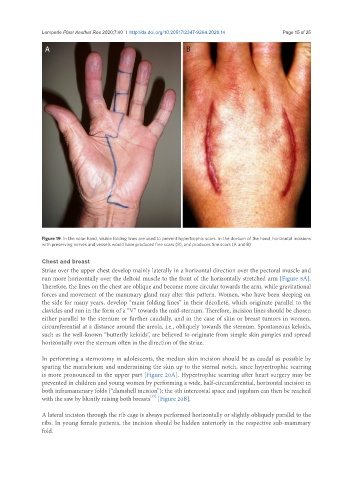Page 446 - Read Online
P. 446
Lemperle Plast Aesthet Res 2020;7:40 I http://dx.doi.org/10.20517/2347-9264.2020.14 Page 15 of 25
A B
Figure 19. In the volar hand, visible folding lines are used to prevent hypertrophic scars. In the dorsum of the hand, horizontal incisions
with preserving nerves and vessels would have produced fine scars (B), and produces fine scars (A and B)
Chest and breast
Striae over the upper chest develop mainly laterally in a horizontal direction over the pectoral muscle and
run more horizontally over the deltoid muscle to the front of the horizontally stretched arm [Figure 8A].
Therefore, the lines on the chest are oblique and become more circular towards the arm, while gravitational
forces and movement of the mammary gland may alter this pattern. Women, who have been sleeping on
the side for many years, develop “main folding lines” in their décolleté, which originate parallel to the
clavicles and run in the form of a “V” towards the mid-sternum. Therefore, incision lines should be chosen
either parallel to the sternum or further caudally, and in the case of skin or breast tumors in women,
circumferential at a distance around the areola, i.e., obliquely towards the sternum. Spontaneous keloids,
such as the well-known “butterfly keloids”, are believed to originate from simple skin pimples and spread
horizontally over the sternum often in the direction of the striae.
In performing a sternotomy in adolescents, the median skin incision should be as caudal as possible by
sparing the manubrium and undermining the skin up to the sternal notch, since hypertrophic scarring
is more pronounced in the upper part [Figure 20A]. Hypertrophic scarring after heart surgery may be
prevented in children and young women by performing a wide, half-circumferential, horizontal incision in
both inframammary folds (“clamshell incision”); the 4th intercostal space and jugulum can then be reached
[37]
with the saw by bluntly raising both breasts [Figure 20B].
A lateral incision through the rib cage is always performed horizontally or slightly obliquely parallel to the
ribs. In young female patients, the incision should be hidden anteriorly in the respective sub-mammary
fold.

